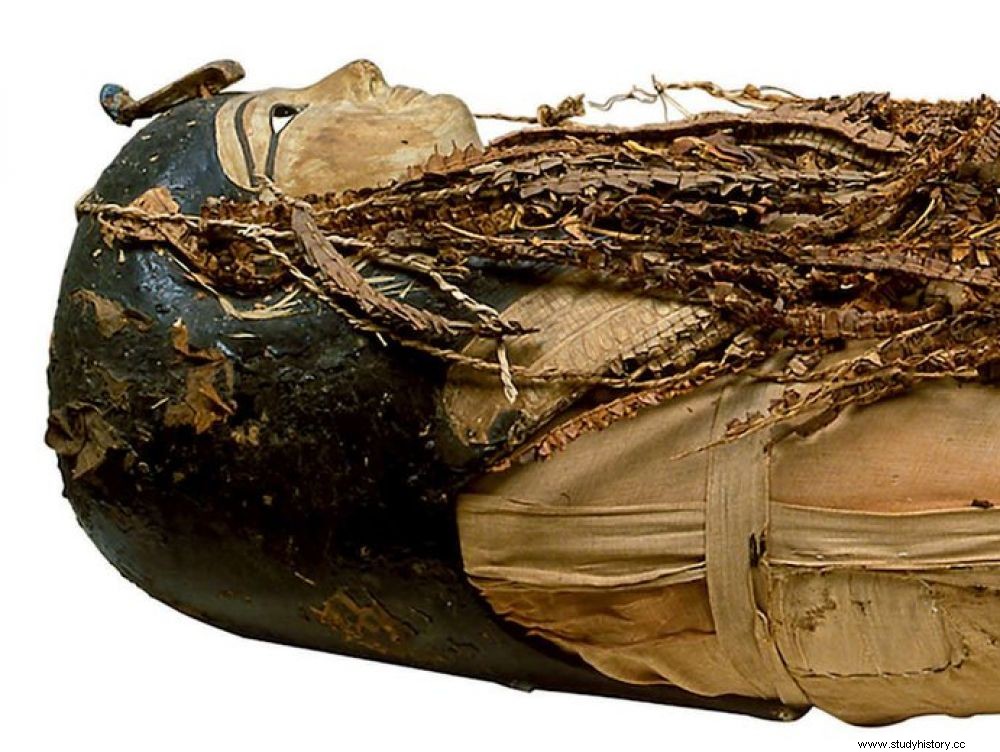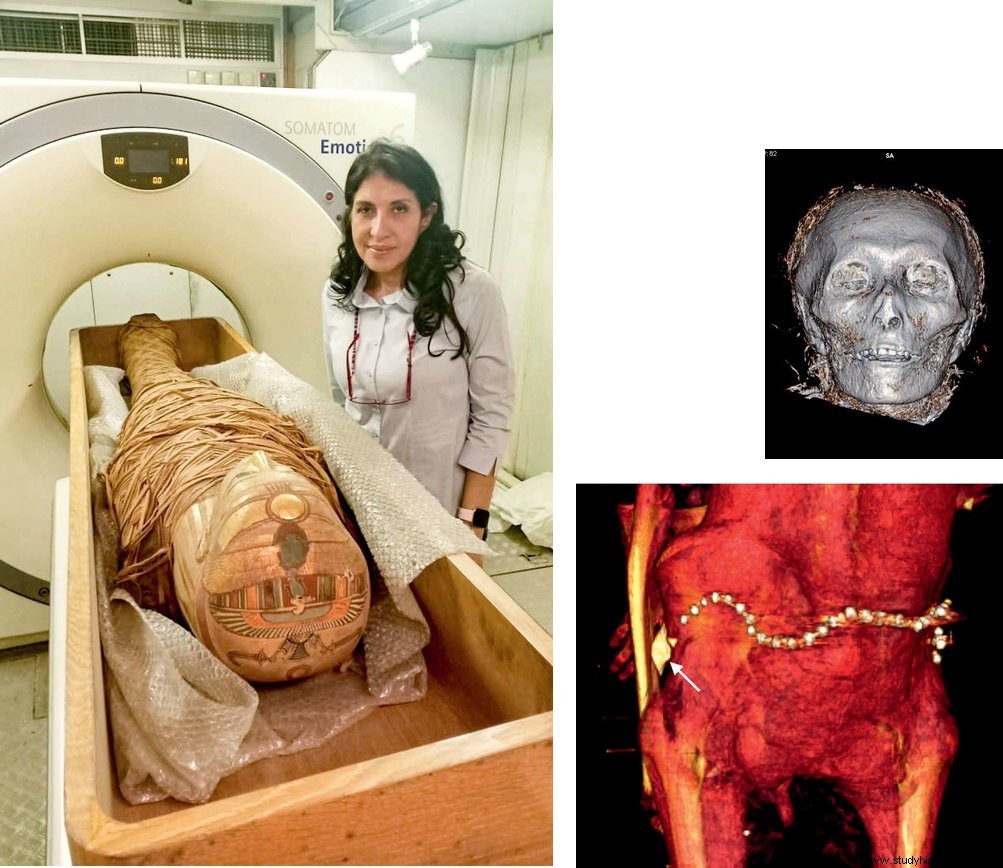The mummy of the Egyptian ruler was scanned by a team of paleo-radiologists and the images obtained made it possible to reconstruct the body in 3D. Morphology, wounds, funerary ornaments... The scientific harvest of this extraordinary operation lives up to expectations.

Not a single strip was removed from the mummy of Amenhotep I, whose different constituent layers could be visualized thanks to computed tomography.
This article is taken from the monthly magazine Sciences et Avenir - La Recherche n°902, dated April 2022.
"Subject, male, approximately 35 years old, exhibits evidence of inflicted injuries post mortem but nothing establishes the cause of his death". The sentence could be extracted from an autopsy report intended for a police investigation. But the patient died more than 3000 years ago! Amenhotep I, pharaoh from 1525 to 1504 BC, second king of the prestigious 18th dynasty, which marks the peak of ancient Egyptian civilization, enjoyed a peaceful reign. The 21st century is putting him back in the limelight:his mummy, one of the few today that has never been unveiled, has been studied virtually. Not a single strip was taken from him, except digitally.
Details unknown until then
Sahar Saleem, professor of radiology at Cairo University (Egypt), international expert in paleo-radiology, passed it to CT-scan, a computer tomography scanner, a non-invasive method commonly used in medicine and applied here in paleo-radiology. The Egyptian researcher made thousands of sections of the mummy's body, thinner than a hair, then put together to reconstruct the body in 3D. She publishes her findings in an article in Frontiers in Medicine co-signed by Zahi Hawass, former minister under the regime of Hosni Mubarak, back in the service of Egyptian Antiquities.
This article is taken from the monthly magazine Sciences et Avenir - La Recherche n°902, dated April 2022.
"Subject, male, approximately 35 years old, exhibits evidence of inflicted injuries post mortem but nothing establishes the cause of his death". The sentence could be extracted from an autopsy report intended for a police investigation. But the patient died more than 3000 years ago! Amenhotep I, pharaoh from 1525 to 1504 BC, second king of the prestigious 18th dynasty, which marks the peak of ancient Egyptian civilization, enjoyed a peaceful reign. The 21st century is putting him back in the limelight:his mummy, one of the few today that has never been unveiled, has been studied virtually. Not a single strip was taken from him, except digitally.
Details unknown until then
Sahar Saleem, professor of radiology at Cairo University (Egypt), international expert in paleo-radiology, passed it to CT-scan, a computer tomography scanner, a non-invasive method commonly used in medicine and applied here in paleo-radiology. The Egyptian researcher made thousands of sections of the mummy's body, thinner than a hair, then put together to reconstruct the body in 3D. She publishes her findings in an article in Frontiers in Medicine co-signed by Zahi Hawass, former minister under the regime of Hosni Mubarak, back in the service of Egyptian Antiquities.
Penetrating under the wooden mask painted yellow, interfering under the strips of linen, the rays revealed details unknown until then. The mummy is covered from head to toe with flower garlands of red, yellow and blue colors. She wears under the bandages a belt of pearls and gold, about thirty jewels and amulets, one of which is placed on the heart. The body was eviscerated through a vertical incision on the left flank, a common method. On the other hand, unexpectedly, the brain is always present. "It collapsed on the back of the skull, noted Sahar Saleem . During the Eighteenth Dynasty, embalmers most often removed the brains of royal mummies; they inserted a tool into a nostril to break the fragile part of the anterior cranial base, removed soft material and filled the skull with embalming materials. It is not known why some pharaohs like Thutmose II or Amenhotep I kept it. "An amazing practice knowing that decerebration had become widespread during the 18th dynasty, reaching its peak during the Ptolemies (323 to 30 BCE).

The scan performed by radiologist Sahar Saleem (left) revealed the pharaoh's facial features and even his teeth (right), as well as adornments on his body, such as this beaded belt with matching an amulet (below, arrow). COURTESY SAHAR N. SALEEM AND ZAHI HAWASS
The Egyptian radiologist draws a precise portrait of Amenhotep I, who was not yet on his first medical examination. In 1932, Douglas Derry, a professor at the Cairo School of Medicine, took him out of his coffin to – already! - pass it to X-rays. He then estimated his age between 40 and 50 years. In 1967, scientists from the University of Michigan (United States) renewed the examination to make it considerably younger:25 years! Sahar Saleem's study finally gives Amenhotep I the age of 35 at the time of his death. A more rigorous estimate based on the epiphyseal closure of the long bones (which marks the cessation of growth) and on the morphology of the anterior pelvic joint.
If the skeleton measures 1.61 meters in its mortuary box, its real height is estimated at 1.69 meters taking into account the fractures and the size of the tibia. A figure comparable to most New Kingdom kings, between Tutankhamun's 1.67 meters and Ramses II's 1.72 meters. Other discoveries:Amenhotep was circumcised like his contemporaries, and he had perfect teeth. Finally, a few locks of hair remain visible on the back of the skull, and his left ear is adorned with a small piercing. "He looked like his father, Ahmosis I, whose mummy we keep in the Luxor Museum, says Sahar Saleem. They both share that oval face with a narrow chin and nose. Today's genetic studies show that genes have a big impact on facial features, which is why they are passed down from generation to generation. "
Looted and damaged, the mummy had already been restored
Besides the physical description of the pharaoh, the scanner reveals fascinating details about the king's history after his death. The mummy of Amenhotep I was discovered in 1881 in the royal cache of Deir el-Bahari, near the Valley of the Kings, facing Luxor. The high dignitaries of the 21st dynasty (1069-945 BC) had hidden there about twenty royal mummies of the New Kingdom to protect them from thieves. Amenhotep suffered the outrages of looters and numerous post-mortem injuries are visible:broken nose, decapitation, right hand separated from its wrist, left arm dislocated:two fingers missing from the left hand rest in a hole in the abdominal cavity.
However, these wounds were treated by the embalmers of the XXIst dynasty. Five centuries after his death, Amenhotep was thus "restored" twice, first by Pinedjem I, high priest of Amun in Thebes, and ten years later by his son Masaharta, as indicated by hieroglyphs on the sarcophagus. . They put the head back on the neck with resin-treated linen strips. They covered a hole in the abdominal wall and introduced two amulets, replaced the left arm next to the body and rewrapped it. The right limb shows that the arms were originally folded crosswise over the chest, an Osirian position which was to become common and which Amenhotep is the first known to adopt.
Thus, and above all, the scanner rectifies a misconception. Contrary to popular belief, the high priests of the 21st Dynasty had good intentions. "Previously we thought they wanted to reuse the royal burial material for their own purposes, recognizes Sahar Saleem. In reality, here, they offer us a beautiful restoration job. " A point of view shared by Philippe Charlier, medical examiner, archaeo-anthropologist:"The gestures of the desecration of the mummy have been reconstructed. There has been a restoration of bodily integrity where possible, with partial rebandaging and the addition of new talismans that allow Amenhotep to be re-consecrated after temporary desacralization due to grave robbers. "
Little chance of knowing more quickly about this famous pharaoh:Sahar Saleem, who works within the framework of the Egyptian Mummy Project aiming to scan the mummies of the New Kingdom, does not intend to carry out analyzes which could damage Amenhotep. This is because, in the past, most royal mummies were "unwrapped" and seriously damaged, like that of Tutankhamun.
A new home for royal mummies
The mummy of Amenhotep I remained intact thanks to Gaston Maspero, director of Egyptian Antiquities when it was discovered in 1881. He wanted to preserve its perfectly arranged strips and its magnificent death mask. "In the future, with technical progress, we will probably practice other examinations that can teach us more “, predicts Sahar Saleem, who has already scanned 40 New Kingdom mummies.
As for Amenhotep, who had rested since 1902 in the Egyptian Museum in Tahrir Square, Cairo, it was accompanied by 21 other royal mummies that he joined in April 2021, during a "pharaonic" ceremony, the National Museum of Egyptian civilization, in a district of Old Cairo. It should no longer be disturbed, except by visitors who will be able to admire it from April 18.
SLIDESHOW. Several Egyptian mummies joined their new museum in a spectacular show
The turbulent fate of the royal cache
Amenhotep I has come a long way! Looted, hidden, rediscovered by thieves... Life in the afterlife is not a long calm river. The pharaoh rested in the hiding place of Deir el-Bahari, a tomb dug in the mountain to the northwest of the temple of Hatshepsut when in 1870, the two brothers Abd el-Rassoul, inhabitants of the region, unearthed this cave. They kept the secret to themselves and sold its treasures for ten years - papyri, funerary statuettes, jewellery... This profusion of antiquities from the 11th and 10th centuries BC attracted the attention of specialists.
Gaston Maspero, then director of the Egyptian Antiquities Department, led the investigation which quickly identified the Abd el-Rassoul brothers. They denied at first, before one of the two confessed to their trafficking. On July 5, 1881, he led archaeologists to one of the most incredible discoveries in Egyptology:around thirty mummies, including those of the greatest pharaohs:Thutmose III, Seti I, Ramses II and… Amenhotep I! They were accompanied by 5000 to 6000 objects. Unfortunately, for fear of new thefts, Gaston Maspero's assistant emptied the hiding place in a hasty and messy way, without statements or sketches. Some mummies lost their identity. While others are still revealed to us today.



